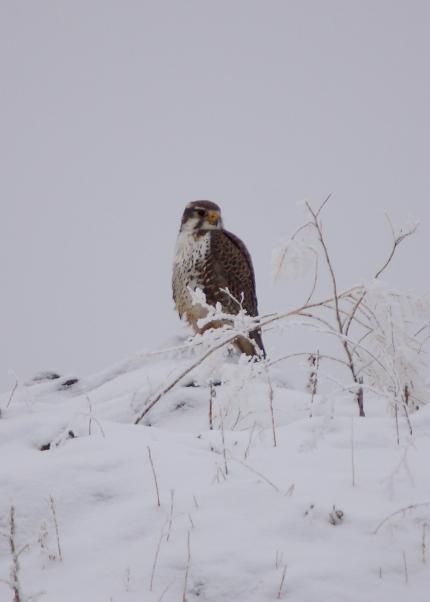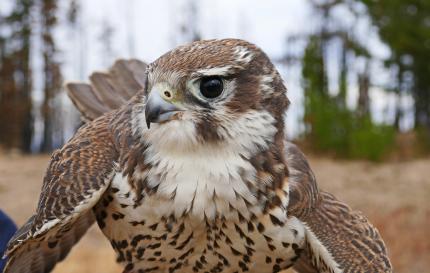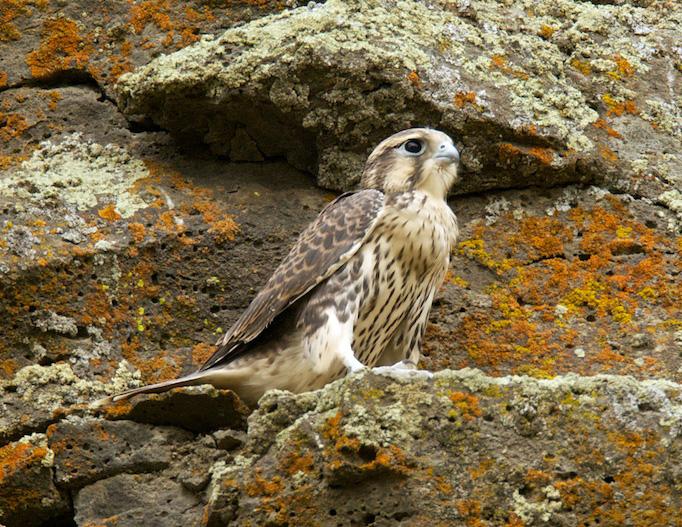The prairie falcon population in Washington is dependent on having suitable cliffs for nesting and quality steppe and shrubsteppe for foraging habitat.
Description and Range
Physical description
The prairie falcon ranges from 15 to about 20 inches in length and has a wingspan that ranges from 3 to 3 ½ feet. This species is pale brown above and has a white underside that is spotted in adults and streaked in immatures. The prairie falcon is paler with more narrow facial markings than the peregrine falcon and, in addition, have dark axillaries (“armpits”) and dark bars on the underside of their wings.
Ecology and life history
Prairie falcons inhabit the arid environments of eastern Washington, nesting on cliffs in arid steppe and shrubsteppe habitat. Prairie falcons use a wide variety of cliffs, from those made of basalt that are 400 feet tall to scant escarpments raised only 20 feet above sloping canyon walls.

Prairie falcons forage on a variety prey common to steppe and shrubsteppe environments. Ground squirrels (Spermophilus species), western meadowlarks, and horned larks are primary prey items during the breeding season.
Washington has a limited number of suitable cliffs for nesting. Nest sites are often on a sheltered ledge or in a pothole in the cliff, and prairie falcons often use abandoned stick nests built by other raptors. Most nest sites are located over one-half mile from human habitation. Most nests occur within one-quarter mile of water. Prairie falcon nest sites are located within foraging territories. Breeding home range can be as large as 150 square miles.
Geographic range
The breeding range of the prairie falcon extends southward from central British Columbia through much of the western United States and reaches as far south as northern Mexico. Prairie falcons winter throughout their breeding range, as far south as central Mexico and as far east as the Mississippi River.
In Washington, prairie falcons have been known to breed in all central and eastern counties except Pend Oreille County. Prairie falcons winter throughout their breeding range in Washington, but the largest wintering populations are found in the central Columbia Basin (Grant, Adams, Franklin, Walla Walla, and Benton counties). Reports of prairie falcons wintering in western Washington have also been reported.
For range-wide distribution and conservation status of this species, check out NatureServe Explorer and the International Union for Conservation of Nature Red List.
Regulations
Licenses and permits

Falconry is the art of training raptors (birds of prey - falcons, eagles, hawks, and owls) to hunt in cooperation with a human and is the sport of actively pursuing wild quarry with those birds. The Washington Department of Fish and Wildlife issues falconry permits, regulates the sport, and remains in contact with the falconry community. No one under any circumstances may keep a raptor as a pet. Only licensed falconers may have birds of prey, and these birds must be flown freely and hunt regularly. State and federal regulations, expertise and dedication of falconers, and self-policing by the falconry community keep the birds in high-quality care. Learn more about the history of this sport and the requirements for falconry in Washington.
Conservation
Conservation Threats and Actions Needed
- Habitat loss or degradation
- Threat: Conversion of steppe and shrubsteppe habitat to agriculture.
- Action Needed: Protect and restore steppe and shrubsteppe to protect foraging habitat.
- Threat: Human habitation close to prairie falcon nests and nesting cliffs.
- Action Needed: Do not have human habitation within one-half mile of nests.
- Management decision needs
- Threat: Effects of agricultural practices that use chemical treatments to control rodents reduces available prey for prairie falcons.
- Action Needed: Promote use of best management practices (Priority Habitat and Species Program) to limit widespread control of ground squirrels and other rodents to areas outside of prairie falcon foraging areas.
See WDFW management recommendations for prairie falcon. (PDF)
Resources
References
Hays, D.W. and F.C. Dobler. 2004. Prairie Falcon. Pages 10-1 – 10-5 in E. Larsen, J. M. Azerrad, N. Nordstrom, editors. Management recommendations for Washington’s priority species, Volume IV: Birds. Washington Department of Fish and Wildlife, Olympia, Washington, USA.

